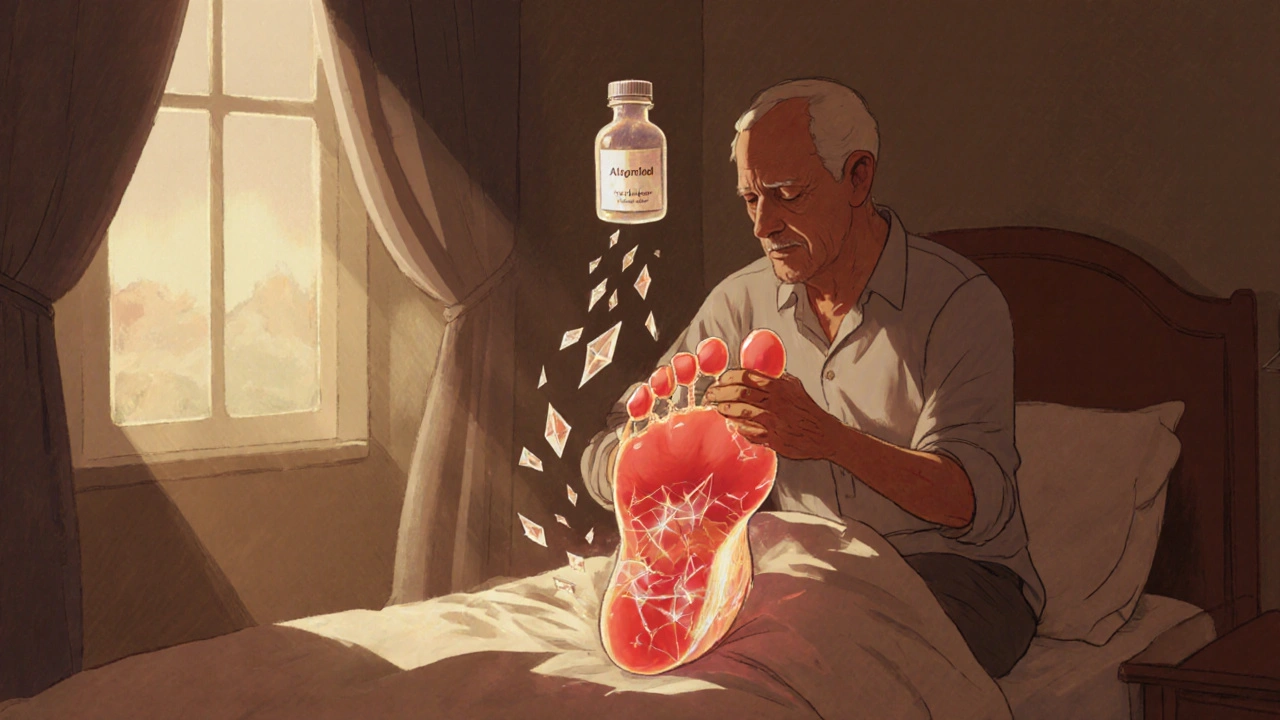
When a gout flare-up hits, it doesn’t just hurt-it paralyzes. The sudden swelling in your big toe, the burning sensation like glass under the skin, the way even a bedsheet feels unbearable. You’ve been told to take allopurinol, but you’re not sure how it works, when to take it, or why your flare-ups still happen. Here’s the truth: allopurinol isn’t a painkiller. It’s a long-term fix. And if you’re taking it wrong, you’re making things worse.
How Allopurinol Actually Works
Allopurinol doesn’t stop pain during a flare. It doesn’t reduce swelling overnight. What it does is lower the amount of uric acid your body makes. Uric acid builds up when your body breaks down purines-found in red meat, shellfish, beer, and even some veggies. When levels get too high, crystals form in your joints. That’s gout.
Allopurinol blocks an enzyme called xanthine oxidase, which is responsible for turning purines into uric acid. Think of it like turning off a faucet that’s slowly filling a bathtub. The water (uric acid) doesn’t drain immediately, but over time, the level drops. That’s why it takes weeks, sometimes months, before you feel the full benefit.
Most people start on 100 mg daily. If your uric acid level is above 6 mg/dL after a few months, your doctor may increase it to 200 or 300 mg. Some people need up to 400 mg, especially if they’ve had multiple flares or tophi (those lumpy deposits under the skin). Never adjust your dose on your own. Too much too fast can trigger more flares.
Why Flare-Ups Keep Happening Even on Allopurinol
If you’re on allopurinol and still getting flares, it’s not because the drug isn’t working. It’s because your body is adjusting. As uric acid levels drop, existing crystals start to dissolve. That process irritates your joints-like sandpaper scraping inside your toe. It’s not a failure. It’s a sign the treatment is working.
Studies show that up to 70% of people on allopurinol have at least one flare in the first 6 months. That’s normal. The trick is to prevent those flares from getting worse. That’s where colchicine or low-dose NSAIDs come in. Most doctors prescribe a low daily dose of colchicine (0.5-0.6 mg) for the first 3 to 6 months while allopurinol kicks in. This isn’t optional-it’s part of the plan.
Skipping this step is the #1 reason people think allopurinol doesn’t work. They take it, get a flare, assume it’s useless, and quit. Then they wonder why their gout keeps getting worse.
When to Take Allopurinol (And When Not To)
Take allopurinol at the same time every day. It doesn’t matter if it’s morning or night-consistency matters more. But here’s the catch: never start allopurinol during a flare. That’s a common mistake. Starting it while your joint is inflamed can make the flare last longer and feel worse.
Wait until the flare settles down. That means no redness, no swelling, no pain when you move your toe. Then start the medication. If you’re unsure, check with your doctor. Some people get a short course of prednisone to calm the flare before starting allopurinol.
Also, take it with food and a full glass of water. Allopurinol can increase your risk of kidney stones if you’re dehydrated. Drink at least 2 liters of water daily. That’s not just advice-it’s medical necessity.
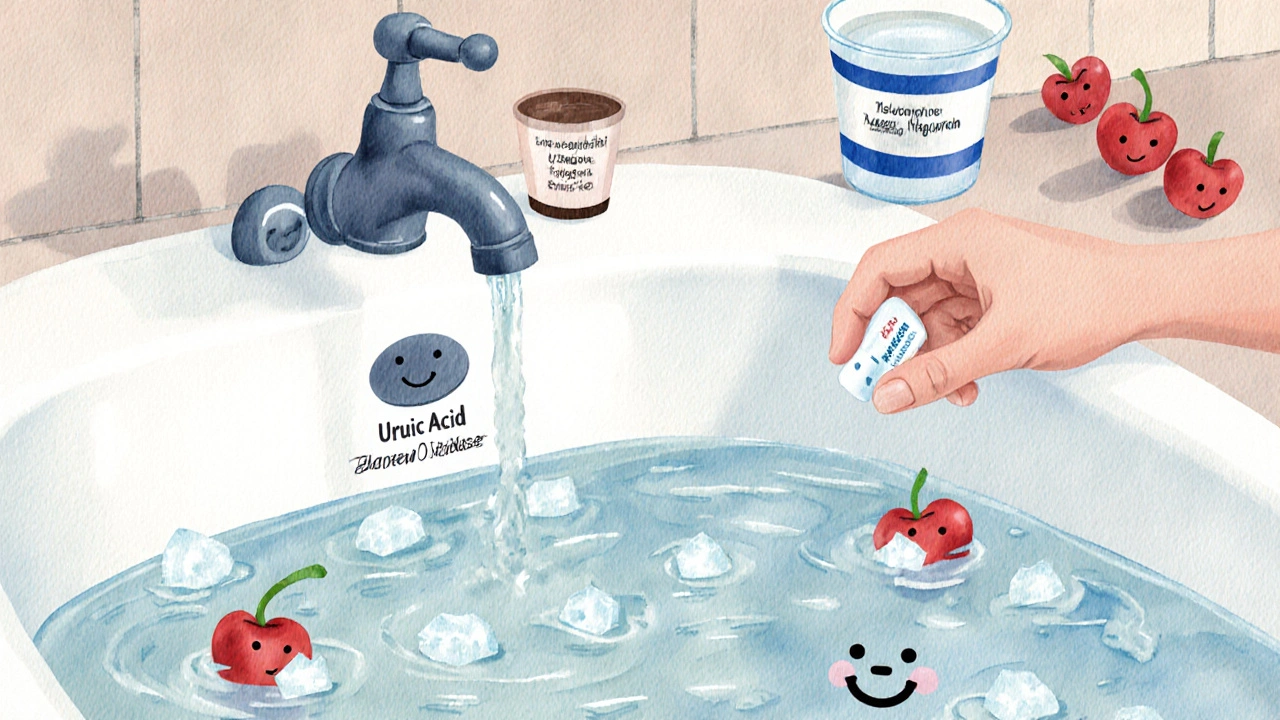
Diet Isn’t Magic, But It Matters
You can’t eat your way out of gout. But you can make allopurinol work better. Purine-rich foods are the obvious trigger: organ meats, sardines, mackerel, anchovies, and beer. But what most people miss are the sneaky ones: sugary drinks, especially fructose-sweetened sodas and fruit juices. A 2023 study in The Lancet found that people who drank one sugary soda a day had a 40% higher risk of gout flares-even if they were on allopurinol.
Alcohol is another silent saboteur. Beer is the worst because it’s high in purines and blocks uric acid excretion. Hard liquor is next. Wine? In moderation, it’s less risky. But if you’re still having flares, skip it entirely.
On the flip side, dairy-especially low-fat milk and yogurt-can help. Studies show that daily dairy intake lowers uric acid levels. Cherries, tart or sweet, have been linked to fewer flares. Not because they’re a cure, but because they reduce inflammation. Eat a handful a day. It’s simple, safe, and supported by real data.
What to Avoid: The Hidden Triggers
Some triggers aren’t obvious. Diuretics (water pills) for high blood pressure? They can raise uric acid. If you’re on hydrochlorothiazide or furosemide, talk to your doctor. There are alternatives that don’t worsen gout.
Weight loss helps-but do it slowly. Losing more than 1-2 kg per week can cause a temporary spike in uric acid. Crash diets? They trigger flares. Aim for steady, sustainable loss. Even 5-10% of your body weight can cut flare frequency in half.
Stress and sleep deprivation also play a role. Chronic stress raises cortisol, which can interfere with uric acid clearance. Poor sleep? It’s linked to higher inflammation. If you’re struggling with sleep or anxiety, don’t ignore it. It’s part of your gout management.
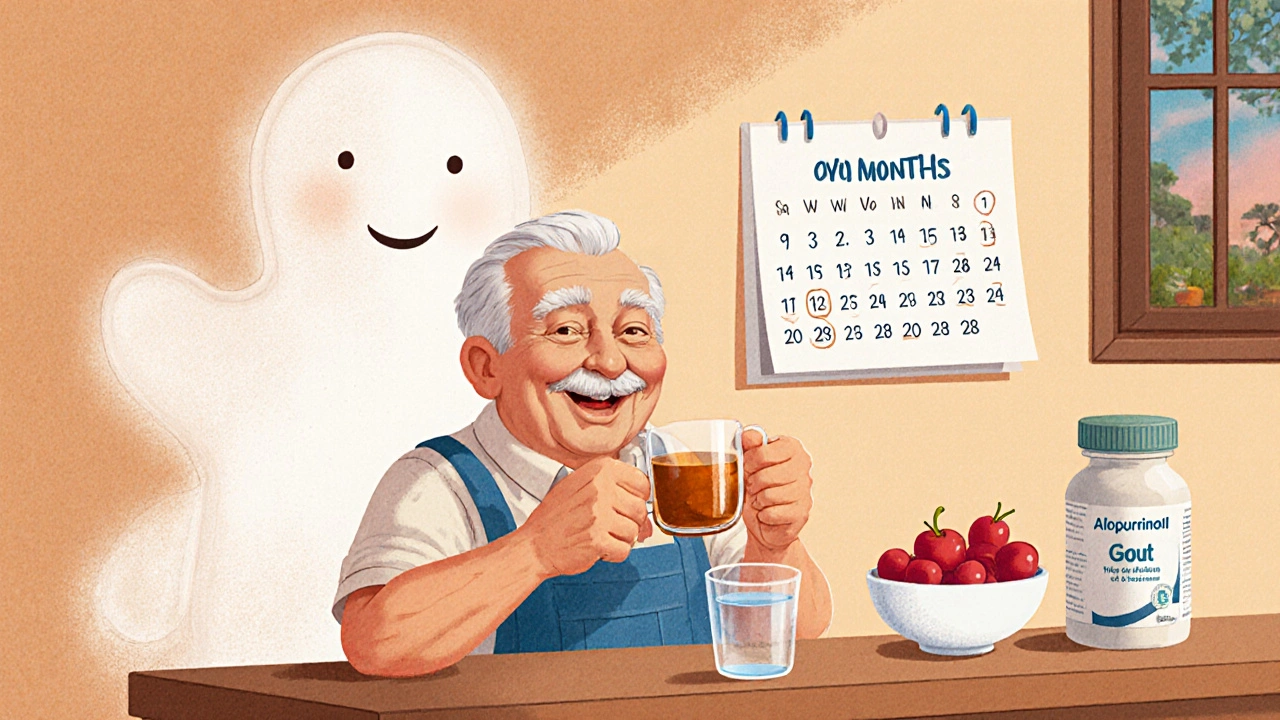
Monitoring Progress: What to Track
Don’t just take your pill and hope for the best. Track two things:
- Your uric acid level-get a blood test every 3 months until it’s under 6 mg/dL, then every 6-12 months after that.
- Your flare frequency-keep a simple log: date, joint affected, pain level (1-10), what you ate, how much you drank, sleep quality.
After 6-12 months on allopurinol, most people see flares drop from weekly to once every few months. If you’re still having flares every 2-3 weeks after a year, your dose might be too low. Or you’re still hitting hidden triggers.
Some people need to combine allopurinol with febuxostat if uric acid stays high. That’s not a failure-it’s a next step. Your doctor can test for HLA-B*58:01 gene variants, which increase the risk of severe reactions to allopurinol. If you’re of Asian or African descent, this test is often recommended before starting.
Long-Term Success: It’s a Lifestyle, Not a Pill
Allopurinol isn’t a cure. It’s a tool. The real win is preventing joint damage, tophi, and kidney problems. Left untreated, gout can destroy cartilage and lead to permanent disability. But with consistent allopurinol use, hydration, diet tweaks, and avoiding triggers, most people live flare-free.
One patient I worked with in Brisbane-58, a retired fisherman-used to have flares every month. He was on 300 mg allopurinol, took colchicine daily, stopped beer, cut out sugary drinks, drank 3 liters of water a day, and ate yogurt every morning. Within 8 months, he had zero flares. He still eats salmon once a week. He just doesn’t drink the beer with it.
That’s the secret. It’s not perfection. It’s consistency. You don’t have to give up everything. You just have to be smarter about what you keep.
When to Call Your Doctor
Call your doctor if:
- You develop a rash, fever, or swollen lymph nodes-this could be a rare but serious reaction to allopurinol.
- Your urine turns dark or you feel pain when you pee-signs of kidney stones.
- You’re still having flares after 12 months on a stable dose.
- You miss doses regularly and can’t stick to the routine.
Don’t wait. Gout is manageable. But only if you treat it like the chronic condition it is-not a one-time problem.
Can I stop taking allopurinol if I haven’t had a flare in a year?
No. Stopping allopurinol lets uric acid levels rise again, and crystals rebuild in your joints. Most people need to take it for life. If your uric acid stays below 6 mg/dL for years, your doctor might consider a very slow taper-but only under strict monitoring. Never quit cold turkey.
Does allopurinol cause weight gain?
No, allopurinol itself doesn’t cause weight gain. But if you’re still eating high-purine foods or drinking sugary drinks, you might gain weight-and that can worsen gout. Weight gain is a lifestyle issue, not a drug side effect.
Is it safe to drink alcohol while on allopurinol?
Moderate wine may be okay for some, but beer and hard liquor are risky. Alcohol increases uric acid production and reduces how fast your body removes it. Even if you’re on allopurinol, drinking heavily can still trigger flares. If you’re still having attacks, skip alcohol entirely.
How long does it take for allopurinol to start working?
It takes 2-6 weeks for uric acid levels to drop. But it can take 3-6 months before you notice fewer flares. That’s because existing crystals need time to dissolve. Don’t expect quick results. Patience and consistency are key.
Can I take ibuprofen with allopurinol?
Yes, but only for short-term flare pain. Ibuprofen and other NSAIDs help with inflammation during a flare. But they don’t lower uric acid. Don’t rely on them long-term-they can damage your kidneys, especially if you already have gout-related kidney issues. Use them as needed, not daily.
What foods should I avoid with allopurinol?
Avoid organ meats (liver, kidney), shellfish (shrimp, lobster), sardines, anchovies, and beer. Also cut out sugary drinks and excessive fructose. Red meat is okay in small amounts-limit to 2-3 times a week. Focus on vegetables, low-fat dairy, whole grains, and cherries.

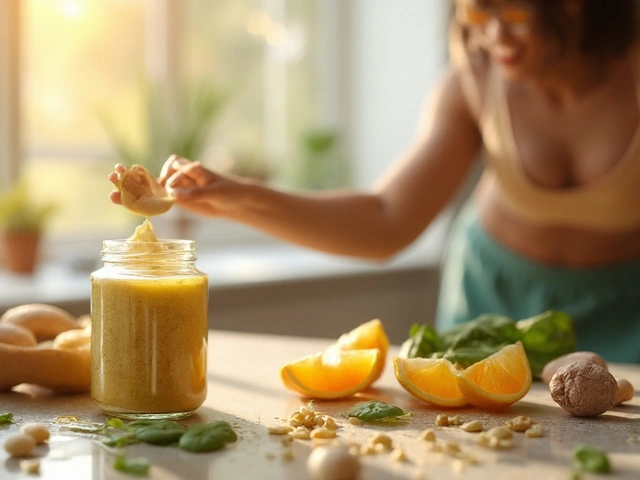
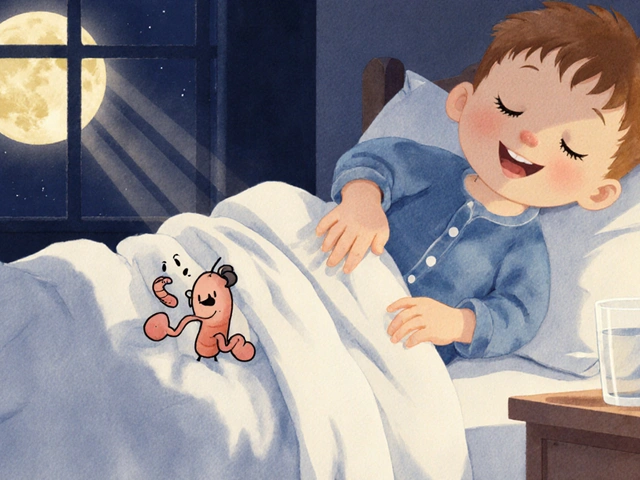
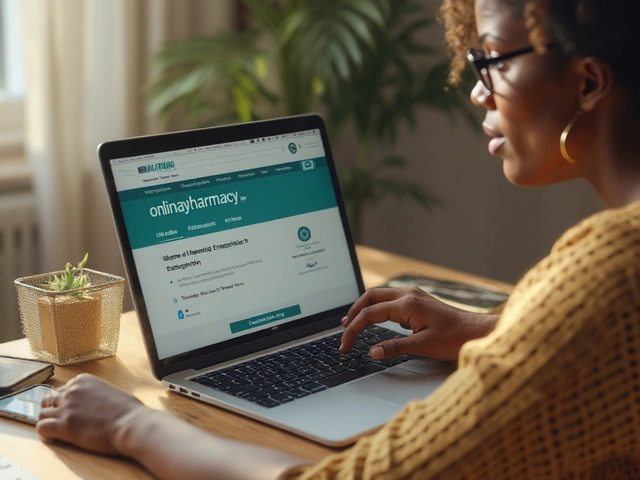



Katie Ring
October 31, 2025 AT 07:48Allopurinol isn't magic-it's a slow burn. I used to think if I didn't feel better in a week, it was junk. Then I learned: dissolving crystals is like sanding down a rusted pipe. It's messy, it stings, and you don't see results until you're already halfway through. The colchicine tip? Game changer. Took me six months to stop treating it like a suggestion.
Adarsha Foundation
November 2, 2025 AT 01:37Thank you for this. In India, many doctors still don’t explain the long-term nature of allopurinol. Patients stop when the pain goes away, then come back with worse tophi. This post should be shared with every clinic in Delhi and Mumbai.
Alexa Apeli
November 2, 2025 AT 04:05THIS. 🙌 I was on allopurinol for 8 months before I realized I was supposed to keep taking colchicine too. I thought it was just for flares. Now I’m flare-free for 14 months. You’re a lifesaver. 💖
Eileen Choudhury
November 3, 2025 AT 10:01OMG YES. I used to chug soda like it was water-until I read that one study about fructose. Switched to sparkling water with lime and cherry extract. My flares dropped from weekly to once every 4 months. It’s not about being perfect-it’s about being stubbornly consistent. You got this, fam. 💪
Zachary Sargent
November 4, 2025 AT 09:38I’ve had gout for 12 years. I’ve tried everything. This post? Finally someone who gets it. No fluff. No ‘just drink more water’ platitudes. Real talk. I’m printing this and taping it to my fridge.
Andy Ruff
November 5, 2025 AT 03:39Let me be blunt: if you’re still having flares after six months on allopurinol, you’re either lazy, delusional, or both. You think cherry juice fixes everything? It doesn’t. You think ‘moderate’ wine is okay? It’s not. You’re not ‘managing’ gout-you’re just delaying the inevitable joint destruction. Get your uric acid below 5 mg/dL or stop pretending you care. This isn’t a lifestyle choice-it’s a medical obligation.
Matthew Kwiecinski
November 5, 2025 AT 21:30Actually, the HLA-B*58:01 screening isn’t just for Asians or Africans-it’s recommended for all populations with high gout burden, per ACR guidelines. Also, the 40% increased risk from sugary drinks? That’s from the 2023 Lancet meta-analysis, not just one study. And you missed mentioning that even diet soda may elevate risk via artificial sweeteners. Don’t oversimplify.
Manuel Gonzalez
November 5, 2025 AT 23:28Great breakdown. I’ve been on allopurinol for 3 years now. Started at 100mg, now at 300mg. Still drink coffee, eat chicken, and have a glass of wine on weekends. The key? Hydration. I drink a liter before bed. My kidney stones? Gone. My flares? Rare. Consistency beats perfection every time.
Brittney Lopez
November 7, 2025 AT 08:37To anyone reading this and thinking ‘I can’t do this’-you can. I was the person who skipped doses, drank soda, and blamed the medicine. Then I started writing down my meals and sleep. Just a notebook. No fancy app. One year later, I haven’t had a flare. You don’t need to be perfect. You just need to show up.
Jens Petersen
November 8, 2025 AT 21:08Let’s be real-most people who write about gout are either doctors who’ve never had it or patients who think cherry juice is a cure. This? This is the first post I’ve seen that doesn’t sugarcoat it. The part about diuretics? Spot on. Hydrochlorothiazide is a gout trap. And the fact that you mentioned tophi? Most people don’t even know what those are. You’re not just educating-you’re saving joints. Respect.
Dade Hughston
November 10, 2025 AT 17:07